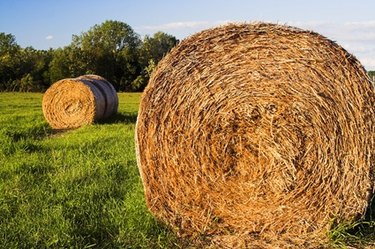
In many agricultural and farming areas you can see stacks and mounds of cylinder-shaped hay bales covered in a white plastic film, resembling oversized marshmallows. It is a common practice for farmers to cover the hay that they store outside with plastic to protect it from the elements.
Hay in the U.S.
Video of the Day
Roughly 60 million acres of U.S. farm land are used to produce over 150 million tons of hay. When stored properly, hay can last for a very long period of time without losing its nutritional value. Hay is primarily used as food for livestock.
Video of the Day
Uncovered Hay
Hay that remains uncovered while out in the elements can incur a lot of damage if weather conditions are not ideal. Hay that is exposed to rain can reach high levels of moisture, which often results in crop losses. When rain passes through the hay it strips away nutrients. It is common for farmers to experience a large percentage of lost crop when hay is stored outdoors.
Hay Moisture
Hay moisture levels can be tested to ensure that they do not exceed a safe level. When the moisture found in hay reaches a high level—usually anything above 20 percent—it can result in the overgrowth of bacteria, fungus and mold. Depending on how large the hay bale is, the surface layers of the hay may be the only portions to experience damage from rain.
Covering Hay
To protect hay from the elements, farmers may choose to cover it with a tarp, wrap it in a plastic sheet or secure a cap on top of it. Wrapping plastic or a tarp around the hay bale will make the cover more secure and less likely to be affected by the wind.